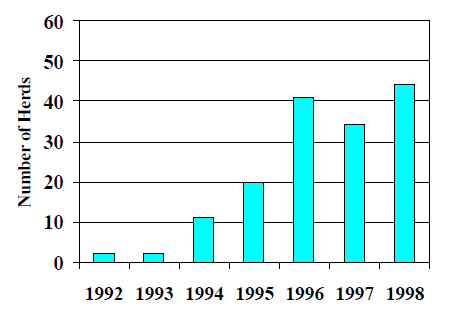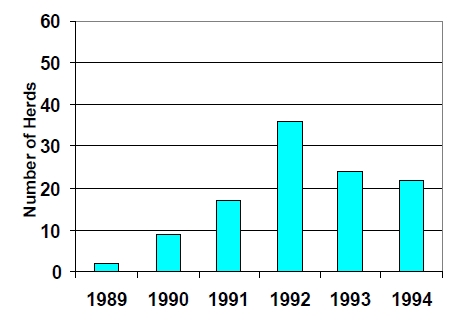Mycoplasma Mastitis
Mycoplasma Mastitis. Can you Control it on Your Farm?
Published: July 30, 2012
By: Pamela L. Ruegg (University of Wisconsin)
Introduction
Mastitis is a well-recognized and costly disease of dairy cattle. Most farmers are well acquainted with traditional causes of mastitis such as Staphylococcus aureus and Streptococcus agalactia. The widespread adoption of standard mastitis control practices such as teat dipping, dry cow therapy, appropriate treatment, judicious culling and good milking preparation has allowed many dairy farmers to control contagious forms of mastitis. In a recent study, Staph aureus and Strep ag accounted for only 8% of clinical mastitis cases in Ontario dairy herds. While these traditional forms of mastitis are now controllable, mastitis continues to require management attention
Other organisms have emerged to fill the niche created by the control of contagious organisms. An organism that is increasingly isolated from clinical mastitis in Wisconsin is Mycoplasma bovis (Fig 2). Prior to 1992, there were only 2 confirmed herd outbreaks within Wisconsin, between 1992 and 1998 at least 140 herd outbreaks of that organism were reported. A similar trend has been reported from dairies in New York (Fig 3). Mycoplasma mastitis was once considered to be a disease of large western dairy herds. In recent years it has become recognized in Midwest and Northeastern dairy regions. This presentation will review basic facts about mastitis caused by mycoplasma and discuss control strategies to minimize the risk of an outbreak.
Fig 2: Mycoplasma Diagnosis in Wisconsin

Fig 3: Mycoplasma Diagnosis in New York

What is Mycoplasma?
Mycoplasmas are a group of very small organisms that can be cultured from multiple body sites of both sick and healthy cattle. Some common species of mycoplasma include M. bovis (most commonly cultured from the udder), M. alkalescens (commonly cultured from the respiratory tract, M. bovigenitalium (commonly cultured from reproductive tract) and M. canadense (commonly cultured from joints). While many of these organisms have been isolated from bovine mastitis, M. bovis is the most common mycoplasma species isolated from milk samples in Wisconsin.
What diseases (other than mastitis) can be caused by Mycoplasma?
M. bovis lives naturally in the respiratory tract of cattle throughout the world. Most respiratory tract colonizations of Mycoplasma do not produce symptoms of disease but M. bovis is an important cause of respiratory disease in calves and feedlot cattle. Mycoplasma has also been implicated in joint infections, occasional abortions and ear infections in calves.
What Does Mycoplasma Mastitis Look Like?
The classic symptoms of mycoplasma mastitis have been described:
- Multiple quarters involved
- Dramatically decreased milk production
- Cows appear otherwise healthy but have severe mastitis
- Milk has sandy or flaky sediments in watery or serous fluid
However, cows can develop subclinical infections with mycoplasma and have normal appearing milk. These subclinically infected cows may have intermittent periods of abnormal milk or their milk may continually appear normal. Somatic cell counts of subclinically infected cows will be increased. Cows that have had mycoplasma cultured from their milk should be considered to be permanently infected regardless of the visual appearance of their milk.
How is Mycoplasma Mastitis Diagnosed?
Bacteriologic culture of milk is required for the diagnosis of mycoplasma mastitis. Milk samples from infected quarters, composite milk samples from infected cows or bulk tank samples can be submitted for culturing. Not every mastitis laboratory performs cultures for mycoplasma because special techniques must be used to grow this organism. The Wisconsin Animal Health Laboratory is one Wisconsin laboratory that performs mycoplasma cultures. Even at laboratories that offer mycoplasma culture, the culture is not performed unless it is specifically requested. To detect mycoplasma, milk is plated on different media and incubated for 7 days in a special incubator. In milk samples obtained from individual cows, a negative mycoplasma culture usually means that the organism is not present. However, intermittent shedding of the organism has been reported, so false negative cultures may rarely occur.
Bulk tank culturing is a good way to monitor a herd for the introduction of mycoplasma mastitis. Detection of as few as one infected cow in bulk tank milk from a 1000 cow dairy has been reported. Like cultures of individual cow milk samples, periodic shedding patterns may lead to an occasional false negative bulk tank sample in a herd with infected cattle.
How Does Mycoplasma Mastitis Spread?
Mycoplasma mastitis is classified as a contagious mastitis pathogen because the reservoir for the infection is other infected cattle, including calves. In contrast to other forms of contagious mastitis, mycoplasma infection can spread from the respiratory system to the udder. The spread can occur due to transmission through the air or through the blood stream. A history of respiratory disease or ear infections in calves occasionally precedes outbreaks of mycoplasma mastitis. A common source of infection is the purchase of cows subclinically infected with mycoplasma mastitis. Non-lactating animals are also at risk as they can be subclinically infected prior to freshening. After calving, these animals may never develop clinical mastitis but may shed high levels of mycoplasma organisms in their milk. Transmission between cows can occur during the milking process or through contamination of cow contact areas in the environment.
How can Mycoplasma be Controlled?
The first step in controlling mycoplasma mastitis is recognizing that the disease is present in Wisconsin dairy herds. A strong association between the introduction of new cattle and outbreaks of mycoplasma mastitis has been reported. Mastitis biosecurity programs can be used to decrease the risk of purchasing infected cattle. Bulk tank cultures from the herd of origin should be requested for non-lactating purchased cows and somatic cell counts and composite milk samples from individual cows should be reviewed prior to purchasing lactating cows. Cows that calve after purchase should be isolated until a negative composite milk sample is obtained. Herds that are routinely purchasing cattle should submit bulk tank milk for mycoplasma twice monthly.
The management of sick and fresh cows also contribute to the spread of this organism. Fresh cows should not be housed in the same pens or milked with the same equipment as sick cows. The feeding of waste milk to calves is another source of transmission of this disease throughout the herd. Calves fed infected milk may develop pneumonia, joint infections and head tilts related to ear infections.
When mycoplasma is found in a bulk tank or individual cow culture, the number of infected cows must be determined. Depending upon herd size, there are several strategies that can be considered. If resources allow or the herd is small, composite samples from all cows should be submitted for culture. In larger herds, group milk samples can be submitted by sequentially culturing the bulk tank during milking. Individual milk samples can be obtained from cows only in the infected groups.
There is no treatment for cows that develop mycoplasma mastitis. Antibiotics are totally ineffective for this organism. Cows that are infected with mycoplasma should always be considered as infectious, regardless of their production level, appearance of their milk or subsequent negative milk culture. In most cases, infected cows should be promptly culled. The only exception to this rule is when a culling is financially unacceptable because a large proportion of a herd is infected. In this case a herd specific strict segregation plan should be developed.
References
1. Blackmer PE. 1998. Mycoplasma mastitis in large dairy herds. Sharing 28 years of practice experience. PP 145 in Proceedings of WI Vet Med Assoc, 84th Ann. Conf. WI Vet Med Assoc, Madison WI
2. Gonzalez RN, Sears PM. 1995. Occurrence of bovine mycoplasmal mastitis in herds and cows in the state of New York. PP 128 in Proceedings of Natl Mastitis Coun, National Mastitis Council, Madison WI.
3. Jasper DE. 1981. Bovine mycoplasmal mastitis. Adv Vet Sci Comp Med 25:121.
4. Sargeant JM, Scott HM., Leslie KE et al. 1998. Clinical mastitis in dairy cattle in Ontario. Frequency of occurrence and bacteriologic isolates. Can Vet J 39:33.
5. Thomas C.B., 1998. Bovine mycoplasmas: A practitioners orientation to host and agent interactions. pp 255 in Proceedings of WI Vet Med Assoc, 84th Ann. Conf. WI Vet Med Assoc, Madison WI
This article was originally published on the Milk Quality, University of Wisconsin´s website. http://milkquality.wisc.edu/. Engormix.com thanks for this huge contribution.
Related topics:
Authors:
University of Wisconsin - USA
Recommend
Comment
Share
Recommend
Reply
Intas Pharmaceuticals Ltd.
3 de octubre de 2012
There are certain reference which talk about the efficiacy of floroquinolone - Cipro and Enro in Mycoplasmal Mastitis.
Recommend
Reply

Would you like to discuss another topic? Create a new post to engage with experts in the community.






.jpg&w=3840&q=75)